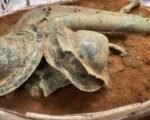In a remarkable discovery reminiscent of the ancient city of Pompeii, scientists have unearthed some of the best-preserved trilobite fossils ever found. These ancient arthropods, dating back over 500 million years, were caught in a pyroclastic flow of volcanic ash that smothered the shallow sea they inhabited, encasing them in ash for half a billion years. Here are the fascinating details:
The Pompeii Connection
- Exceptional Preservation: The fossils represent two species of trilobites that were rapidly buried by volcanic ash as they walked or rested on the sea floor. The resulting three-dimensional molds show details as small as the filaments on the trilobites’ legs and tiny commensal animals attached to their backs.
- Natural Molds: The trilobites formed natural molds within the ash, which eventually turned to stone. This process mirrors how the eruption of Mount Vesuvius buried the inhabitants of Pompeii and Herculaneum in 79 AD.

A Palaeontologist’s Perspective
Dr. Greg Edgecombe, a trilobite specialist at the Natural History Museum, expressed his awe at these incredible specimens: “I’ve been studying trilobites for nearly 40 years, but I never felt like I was looking at live animals as much as I have with these ones. It’s pretty mind-blowing. Everybody who’s seen these images is just gobsmacked.”
The paper describing these exceptional fossils has been published in Science.












